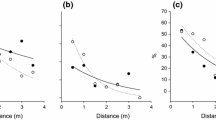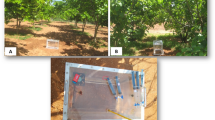Abstract
With the increasing use of tropical peatland for agricultural development, documentation of the rate of carbon dioxide (CO2) emissions is becoming important for national greenhouse gas inventories. The objective of this study was to evaluate soil-surface CO2 fluxes from drained peat under different land-use systems in Riau and Jambi Provinces, Sumatra, Indonesia. Increase of CO2 concentration was tracked in measurement chambers using an Infrared Gas Analyzer (IRGA, LI-COR 820 model). The results showed that CO2 flux under oil palm (Elaeis guineensis) plantations ranged from 34 ± 16 and 45 ± 25 Mg CO2 ha–1 year–1 in two locations in Jambi province to 66 ± 25 Mg CO2 ha–1 year–1 for a site in Riau. For adjacent plots within 3.2 km in the Kampar Peninsula, Riau, CO2 fluxes from an oil palm plantation, an Acacia plantation, a secondary forest and a rubber plantation were 66 ± 25, 59 ± 19, 61 ± 25, 52 ± 17 Mg ha–1 year–1, respectively, while on bare land sites it was between 56 ± 30 and 67 ± 24 Mg CO2 ha–1 year–1, indicating no significant differences among the different land-use systems in the same landscape. Unexplained site variation seems to dominate over land use in influencing CO2 flux. CO2 fluxes varied with time of day (p < 0.001) with the noon flux as the highest, suggesting an overestimate of the mean flux values with the absence of night-time measurements. In general, CO2 flux increased with the depth of water table, suggesting the importance of keeping the peat as wet as possible.






Similar content being viewed by others
References
Agus F, Handayani E, van Noordwijk M et al (2010) Root respiration interferes with peat CO2 emission measurement. In: Proceedings, 19th World Congress of Soil Science, Brisbane, Australia, August 2010
Agus F, Hairiah K, Mulyani A (2011) Measuring carbon stock in peat soils: practical guidelines. Bogor, Indonesia. World Agroforestry Centre (ICRAF) Southeast Asia Regional Program and Indonesian Centre for Agricultural Land Resources Research and Development, Bogor, Indonesia
Agus F, Henson IE, Sahardjo BH et al (2013) Review of emission factors for assessment of CO2 emission from land use change to oil palm in Southeast Asia. Roundtable on sustainable Palm Oil, Kuala Lumpur, Malaysia, October 2013
Ali M, Taylor D, Inubushi K (2006) Effects of environmental variations on CO2 efflux from a tropical peatland in eastern Sumatra. Wetlands 26:612–618
Andriesse JP (1988) Nature and management of tropical peat soils. FAO, Rome
Bloom AA, Palmer PI, Fraser A et al (2010) Large-scale controls of methanogenesis inferred from methane and gravity spaceborne data. Science 327:322–325
Bray RH, Kurtz LT (1945) Determination of total, organic and available phosphorus in soils. Soils Sci 59:39–45
Bremner JM, Mulvaney CS (1982) Methods of soil analysis, part 2: chemical and microbiological properties. Agronomy 9, Soil Science Society of America, Madison, WI, 595 pp
Couwenberg J, Domain R, Joosten H (2010) Greenhouse gas fluxes from tropical peatswamps in Southeast Asia. Glob Chang Biol 16(6):1715–1732
Dariah A, Marwanto S, Agus F (2013) Root- and peat-based CO2 emissions from oil palm plantations. Mitig Adapt Strateg Glob Change. doi:10.1007/s11027-013-9515-6
Davidson EA, Janssens IA (2006) Temperature sensitivity of soil carbon decomposition and feedbacks to climate change. Nature 440:165–173. doi:10.38/nature04514
Domisch T, Finer L, Laine J et al (2006) Decomposition and nitrogen dynamics of litter in peat soils from two climatic regions under different temperature regimes. Eur J Soil Biol 42:74–81
FAO (Food and Agriculture Organization of the United Nations) (1998) World reference base for soil resources. World Soil Resources report 84, FAO, Rome, 84 pp
Furukawa Y, Inubushi K, Ali M et al (2005) Effect of changing groundwater levels caused by land-use changes on greenhouse gas fluxes from tropical peat lands. Nutr Cycl Agroecosyst 71:81–91
Gunarso P, Hartoyo ME, Agus F et al (2013) Oil palm and land use change in Indonesia, Malaysia and Papua New Guinea. Roundtable on Sustainable Palm Oil, Kuala Lumpur, Malaysia, October 2013
Hergoualc’h K, Verchot LV (2011) Stocks and fluxes of carbon associated with land-use change in Southeast Asian tropical peatlands: a review. Glob Biochem Cycles 25, GB2001. doi:10.1029/2009GB003718
Hergoualc’h K, Verchot LV (2013) Greenhouse gas emission factors for land use and land-use change in Southeast Asian peatlands. Mitig Adapt Strateg Glob Change. doi:10.1007/s11027-013-9511-x
Hooijer A, Silvius M, Wösten H et al (2006) PEAT-CO2: assessment of CO emissions from drained peatlands in SE Asia. Delft Hydraulics report Q3943, Delft Hydraulics, Delft, The Netherlands
Hooijer A, Page S, Canadell JG et al (2010) Current and future CO2 emissions from drained peatlands in Southeast Asia. Biogeosciences 7:1505–1514. doi:10.5194/bg-7-1505-2010
Hooijer A, Page S, Jauhiainen J et al (2012) Subsidence and carbon loss in drained tropical peatlands. Biogeosciences 9:1053–1071. doi:10.5194/bg-9-1053-2012
Husen E, Salma S, Agus F (2013) Peat respiration at various water contents and laterite application under controlled laboratory. Mitig Adapt Strateg Glob Change. doi:10.1007/s11027-013-9526-3
SAS Institute (1998) StatView for Windows, version 5.0.1. SAS Institute, Cary, NC
IPCC (2013) 2013 Supplement to the 2006 guidelines: wetlands. Intergovernmental Panel on Climate Change. IGES, Hayama, Japan
Jauhiainen J, Heikkinen JEP, Martikainen PJ et al (2001) CO2 and CH4 fluxes in pristine peat swamp forest and peatland converted to agriculture in central Kalimantan, Indonesia. Int Peat J 11:43–49
Jauhiainen J, Jaya A, Inoue T et al (2004) Carbon balance in managed tropical peat in central Kalimantan. In: Päivänen J (ed) Proceedings of the 12th International Peat Congress, Tampere, Finland, 6–11 June 2004, 653 pp
Jauhiainen J, Takahashi H, Heikkinen JEP et al (2005) Carbon fluxes from a tropical peat swamp forest floor. Glob Chang Biol 11:1788–1797
Jauhiainen J, Hooijer A, Page SE (2012) Carbon dioxide emissions from an Acacia plantation on peatland in Sumatra, Indonesia. Biogeosciences 9:617–630. doi:10.5194/bg-9-617-2012
Jensen LS, Mueller T, Tate KR et al (1996) Soil surface CO2 flux as an index of soil respiration in situ: a comparison of two chamber methods. Soil Biol Biochem 28(10/11):1297–1306
Lloyd J, Taylor JA (1994) On the temperature-dependence of soil respiration. Funct Ecol 8:315–323
Madsen R, Xu L, Claassen B et al (2009) Surface monitoring method for carbon capture and storage projects. Energy Procedia 1:2161–2168
Marwanto S, Agus F (2013) Is CO2 flux from oil palm plantations on peatland controlled by soil moisture and/or soil and air temperatures? Mitig Adapt Strateg Glob Change. doi:10.1007/s11027-013-9518-3
Maswar M (2011) Kajian cadangan karbon pada lahan gambut tropika yang didrainase untuk tanaman tahunan (Carbon stock in the drained tropical peat used for perennial plantation crops). PhD Thesis, Bogor Agricultural University, Bogor, Indonesia
McLean EO (1982) Soil pH and lime requirement. In: Page AL, Baker E, Ellis R Jr et al (eds) Methods of soils analysis, no. 9, part 2. SSSA, Madison, WI, 199 pp
Melling L, Hatano R, Goh KJ (2005) Soil CO2 flux from three ecosystems in tropical peatland of Sarawak, Malaysia. Tellus 57B:1–11
Melling L, Goh KJ, Beauvais C et al (2007) Carbon flow and budget in a young mature oil palm agroecosystem on deep tropical peat. In: Rieley JO, Banks CJ, Radjagukguk B (ed) Proceedings of the International Symposium and Workshop on Tropical Peatland, Yogyakarta, Indonesia. http://www.geog.le.ac.uk/carbopeat/media/pdf/yogyapapers/. Accessed 1 March 2012
Minkkinen K, Laine J, Shurpall NJ et al (2007) Heterotrophic soil respiration in forestry-drained peatlands. Boreal Env Res 12:115–126
Mohamed M, Padmanabhan E, Mei BLH et al (2002) The Peat Soils of Sarawak. Universiti Malaysia, Sarawak Malaysia
Murayama S, Bakar ZA (1996a) Decomposition of tropical peat soils: 1. decomposition kinetics of organic matter of peat soils. Jpn Agric Res Q 30:145–151
Murayama S, Bakar ZA (1996b) Decomposition of tropical peat soils: 2. estimation of in situ decomposition by measurement of CO2 flux. Jpn Agric Res Q 30:153–158
Nelson DW, Sommers LE et al (1982) Total carbon, organic carbon, and organic matter. In: Page AL (ed) Methods of soil analysis, part 2, 2nd edn. Agronomy 9, Am. Soc. of Agron., Madison, WI, 961 pp
Page SE, Siegert F, Rieley JO et al (2002) The amount of carbon released from peat and forest fires in Indonesia during 1997. Nature 420:61–65
Page SE, Morrison R, Mallins C et al (2011) Review of peat surface greenhouse gas emissions from oil pal plantations in Southeast Asia (ICCT White Paper 15). International Council on Clean Transportation, Washington, DC
Parish F, Sirin A, Charman D et al (eds) (2008) Assessment on peatlands, biodiversity and climate change: main report. Global Environment Centre, Kuala Lumpur and Wetlands Int., Wageningen, The Netherlands
Preston MD, Smemo KA, McLaughlin JW et al (2012) Peatland microbial communities and decomposition processes in the James Bay Lowlands, Canada. Front Microbiol 3:70. doi:10.3389/fmicb.2012.00070
Pumpanen J, Kolari P, Ilvesniemi H et al (2004) Comparison of different chamber techniques for measuring soil CO2 efflux. Agric For Meteorol 123:159–176
Raich JW, Potter CS (1995) Global patterns of carbon dioxide emissions from soils. Global Biogeochem Cycles 9:23–36
Ritung S, Wahyunto, Sukarman et al (2011) Peat land map of Indonesia, Scale 1:250.000. Indonesian Center for Agroclimate Res and Dev, Indonesian Agency for Agr. Res. and Dev., Ministry of Agr., Jakarta, Indonesia
Salimin MI, Gandaseca S, Ahmed OH et al (2010) Comparison of selected chemical properties of peat swamp soil before and after timber harvesting. Am J Environ Sci 6:164–167
Schrier-Uijl AP, Anshari G (2013) Methods for determining greenhouse gas emissions and carbon stocks from oil palm plantations and their surroundings in tropical peatlands. Roundtable on Sustainable Palm Oil, Kuala Lumpur, Malaysia, October 2013
Schrier-Uijl AP, Silvius M, Parish F et al (2013) Environmental and social impacts of oil palm cultivation on tropical peat: a scientific review. Roundtable on Sustainable Palm Oil, Kuala Lumpur, Malaysia, October 2013
Silvola J, Alm J, Ahlholm U et al (1996) CO2 fluxes from peat in boreal mires under varying temperature and moisture conditions. J Ecol 84:219–228
Soil Survey Staff (2010) Keys to soil taxonomy, 11th edn. NRCS-USDA, Washington, DC
Stephen JC (1956) Subsidence of organic soils in the Florida Everglades. Soil Sci Soc Am J 20:77–80
Stephens JC, Johnson L (1951) Subsidence of organic soils in the upper Everglades region of Florida. Soil Sci Soc Florida Proc 11:191–237
Tie YL (1988) Report on a semi-detailed soil survey of the Sibu-Bintangor Deep Peat Area. Sibu/Sarikei Division. Report no. 260. Soil Div., Research Branch, Dept. of Agr., Sarawak, Malaysia
Ueda S, Go C-S U, Yoshioka T et al (2000) Dynamics of dissolved O2, CO2, CH4 and N2O in a tropical coastal swamp in southern Thailand. Biogeochemistry 49:191–215
Wösten JMH, Ismail AB, van Wijk ALM (1997) Peat subsidence and its practical implications: a case study in Malaysia. Geoderma 78:25–36
Acknowledgements
This research was funded by the European Community's Seventh Framework Programme (FP7-ENV-2008-1), Project Number No. 226310 (REDD-ALERT). The authors wish to thank Dr. Robin Mathews, Ms. Jenny Farmer and George Dyer from James Hutton Institute and Dr. Meine van Noordwijk of the World Agroforestry Centre for their advice on this paper.
Author information
Authors and Affiliations
Corresponding author
Rights and permissions
About this article
Cite this article
Husnain, H., Wigena, I.G.P., Dariah, A. et al. CO2 emissions from tropical drained peat in Sumatra, Indonesia. Mitig Adapt Strateg Glob Change 19, 845–862 (2014). https://doi.org/10.1007/s11027-014-9550-y
Received:
Accepted:
Published:
Issue Date:
DOI: https://doi.org/10.1007/s11027-014-9550-y




